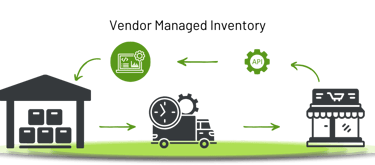Inventory Management Strategies and Methods
Table of Contents
Inventory management is often an overlooked part of business operations, even though it plays a significant role in a company's finances. Before starting or growing a business, especially one that deals with physical goods like retail, wholesale, or manufacturing, owners and managers must consider inventory storage costs. Is it a smart investment? Will your customers be patient enough to wait for orders from suppliers? These are key questions to think about. How you manage your inventory now will shape your business operations in the future, so it's important to know the available strategies and methods for effective inventory management.
Understanding the Difference Between Strategies and Methods
Before we get into the details, let's first explain the difference between inventory management strategies and methods.
Strategies are the overall plans that guide a company's operations, including long-term goals related to inventory management. The strategy you choose will determine how much inventory to hold, when to reorder, and how to meet customer needs. Some well-known inventory management strategies include the "Push and Pull" strategy, the "Just-In-Time" (JIT) strategy, and Vendor Managed Inventory (VMI).
Methods are the practical techniques used to manage inventory according to your chosen strategy. These methods involve daily tasks that ensure your inventory management system runs smoothly. Examples include ABC analysis, Economic Order Quantity (EOQ), the Min-Max method, and the Theory of Constraints (TOC).
In simpler terms:
Strategies to answer the "what" and "when" questions in inventory management.
Methods answer the "how" questions.
Inventory Management Strategies
Push Strategy
The push strategy relies on forecasted demand. Companies produce or order goods in advance, predicting what customers will need in the future. These products are then pushed through the supply chain, filling storage locations until the expected demand arises. This method is often used in industries where demand is steady and predictable.


This strategy was more popular in the past, especially when production capacity was the main limitation. At that time, demand was consistently rising, and customers were eager to buy whatever was available.
However, times have changed, and so has customer behavior. Businesses now carefully assess the costs of holding inventory, consider the financial impact of excess stock and decide what to do with unsold products. Today, the focus is not just on efficient operations but also on smart resource and inventory management.
Pull Strategy
The pull strategy is driven by actual demand rather than forecasts. Instead of producing or ordering goods in advance, businesses wait for customer orders before starting production or purchasing. This approach helps reduce excess inventory and storage costs, as products are only made or ordered when there's a clear need for them.


The pull strategy works well in industries where demand is less predictable, where customer preferences can change quickly, or in environments where it's important to adapt swiftly. By responding directly to customer orders, companies can be more flexible and quicker to adjust to market changes.
Just-In-Time (JIT) Strategy
JIT is a method where materials and products are ordered just before they are needed in the production process. This helps reduce storage costs and excess inventory.


However, JIT requires accurate demand forecasts and a reliable supply chain to avoid inventory shortages. If these conditions aren't met, production delays can happen, leading to customer dissatisfaction and possibly losing business to competitors. JIT is often used in manufacturing.
Vendor Managed Inventory (VMI)
VMI shifts the responsibility of managing inventory levels to the supplier. In this setup, the supplier monitors the retailer's sales and inventory levels and decides when and how much inventory to replenish. This approach helps the retailer avoid excess inventory, as the supplier takes on the task of maintaining the right stock levels based on actual demand. This can improve inventory management, reduce storage costs, and enhance supply chain efficiency for both parties.


Inventory Management Methods
When talking about inventory management methods, it's useful to consider them from two perspectives: assortment management and inventory-level management. Both are important for effective inventory management and overall business success, but they serve different purposes in the company's management process.
Assortment Management Methods
Assortment management involves deciding which products to stock and how to prioritize them. This includes categorizing inventory based on factors like sales importance, value, demand patterns, and customer preferences. The goal is to focus on the most important products, optimize the product mix, and align offerings with customer demand. This helps companies decide which products to keep in stock, what variety to offer, and which items need special attention.
ABC Analysis
ABC analysis categorizes inventory into three groups based on their importance and value to the business:
Category A: High-value products that are most profitable. These items are sold less frequently and make up a smaller portion of inventory, but they are important enough to require close monitoring and tight control to avoid stockouts and lost sales. The availability of Category A products directly affects business operations and profitability.
Category B: Moderately important products that sell more frequently than Category A items. These items generate a significant amount of sales and profit and typically require slightly larger inventory levels. Category B products should be reviewed periodically to determine if they should be moved to Category A or C.
Category C: Low-value products that contribute the least to profit but are held in large quantities. These items require the least attention.
ABC analysis is based on the 80/20 rule, which suggests that 20% of products (usually Category A items) generate 80% of revenue. In this model, Category A products represent 10-20% of the items but generate the most revenue. Category B items follow with moderate revenue, while Category C items, although they may sell more frequently, contribute the least to overall profit.
XYZ Analysis
XYZ analysis categorizes inventory based on demand variability, unlike ABC analysis which focuses on value and importance. XYZ analysis looks at how predictable a product's demand is.
Category X: Products with very stable and predictable demand, often high-turnover items with consistent sales patterns. These are easier to manage and require less inventory reserve.
Category Y: Products with moderately variable demand. Their sales may fluctuate due to seasonal factors, market trends, or other external influences. Managing Y category inventory requires more attention to forecasting and may involve holding larger safety stock levels to avoid stockouts during demand spikes or excess inventory during downturns.
Category Z: Products with highly unpredictable demand and irregular sales patterns. These may be specialized products or those with niche markets. Managing Z category inventory is challenging due to its volatile demand, often requiring flexible strategies or JIT methods to minimize excess inventory risks.
XYZ analysis complements ABC analysis by introducing the factor of demand unpredictability into assortment management. Companies using both ABC and XYZ analyses should identify the products that bring the most profit and need the most attention and resources.
Inventory Level Management Methods
Inventory level management involves determining how much of each product to keep in stock and when to reorder. This includes setting inventory levels, calculating reorder points, determining order quantities, and maintaining safety stock. The goal is to ensure that the company has the right amount of inventory at the right time, avoiding both excess inventory and stockouts.
Min-Max Method
Also known as the Reorder Point method, the Min-Max method sets minimum and maximum inventory levels:
Min. Level: The level at which inventory should be reordered to replenish stock.
Max. Level: The maximum level to which inventory is ordered.
The Min-Max method works by ordering inventory up to the maximum level once the minimum level is reached. This approach allows for controlling inventory levels, often meeting the supplier's minimum order conditions and avoiding stockouts since there will still be a minimum quantity left in stock until the replenishment order arrives.
Economic Order Quantity (EOQ)
EOQ is a formula used to calculate the ideal order quantity that minimizes inventory costs, including holding, ordering, and transportation costs. EOQ differs from MOQ (Minimum Order Quantity), which refers to the smallest quantity a supplier will accept for an order. EOQ, on the other hand, is the quantity that is most cost-effective to order based on these conditions.
Safety Stock
Safety stock is an additional inventory buffer that protects against unexpected spikes in demand or delays in supply. It helps prevent stockouts and ensures customer needs are met even when demand conditions change. This method is often used alongside other methods, such as the Reorder Point or TOC.
FIFO (First In, First Out)
FIFO is a method where the oldest products are sold first. This approach is particularly relevant for companies dealing with perishable goods or products with a limited shelf life
While FIFO effectively ensures that inventory doesn't become obsolete, it's more commonly associated with warehouse management rather than overall inventory management. The focus is on efficiently organizing the warehouse so that items are received, stored, and picked for customers in the correct order.
Demand Forecasting
Demand forecasting involves predicting future inventory needs by analyzing historical data, market trends, and statistical models. Forecasting helps align inventory levels with planned demand, reducing the risk of excess inventory or stockouts.
While demand forecasting often relies on comparing current needs with previous periods, it's crucial to consider additional factors that may have influenced past sales, such as promotions, competitor actions, weather conditions, and other external influences. Inventory forecasting should be an ongoing process, considering both inventory levels and these factors. This continuous approach helps companies adapt and respond effectively, but it's essential to maintain balance and avoid chaos by attempting to account for all possible variables.
Theory of Constraints (TOC)
TOC inventory management aims to prevent chaotic work or processes that don't benefit the business. Instead of relying solely on past data to predict future demand, TOC focuses on meeting current customer needs. The primary goal is to ensure you have the right amount of goods in the right place at the right time, with inventory levels that match what customers are currently buying.
In TOC, a buffer is set for each product, dynamically adjusting in response to real-time changes in conditions. These buffers define not only the amount of inventory held but are carefully calculated based on supplier lead times, incoming orders, and current sales. This method helps companies remain flexible and ensures inventory levels match actual demand without excess or insufficient stock.
Choosing the Right Inventory Management Strategy and Method
Inventory management is more complex than it may initially appear. It involves developing a solid strategy and selecting the appropriate methods that suit your business. As discussed in this article, several methods are available, each with its strengths and weaknesses.
To make the right choice, start by analyzing your business environment and competitors. Communicate with your suppliers, as their operating model can significantly impact your strategies and methods. Additionally, stay informed about the latest trends, tools, and practices in the market.
When choosing inventory management software, keep in mind that most solutions come with integrated methods—sometimes several. By selecting specific software, you also commit to using certain methods, so it's important to understand what each offers and how it aligns with your business needs.
We hope this article has helped you understand the importance of inventory management strategy and how it differs from method.
If you want to know what methods are integrated into the fluenSTOCK tool, please contact us.


